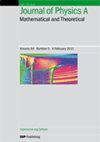恩鲁-德威特模型及其联合作用希尔伯特空间
IF 2.1
3区 物理与天体物理
Q2 PHYSICS, MATHEMATICAL
Journal of Physics A: Mathematical and Theoretical
Pub Date : 2024-07-23
DOI:10.1088/1751-8121/ad6365
引用次数: 0
摘要
在这项研究中,我们将应用于弯曲时空量子场论的 Unruh-DeWitt (UDW)粒子探测器模型与自旋玻色子(SB)模型的严格构建联系起来。经过一些修改,我们证明现有的关于 SB 基态存在的结果可以适用于 UDW 模型。在涉及(3+1)维全局双曲时空中无质量标量场的最相关情景中,UDW 模型描述了光-物质相互作用的简化模型,我们认为时空涂抹函数的常见选择可以调节模型的紫外行为,但仍然会表现出红外发散。特别是,这意味着模型的联合相互作用希尔伯特空间不能用二维复希尔伯特空间和真空表示的福克空间的张量乘积来描述这一众所周知的预期。我们的研究澄清了哈格定理和 SB 模型中的红外玻色子所导致的障碍之间的联系,并为在涉及多个探测器的 UDW 框架中更严格地研究纠缠和通信铺平了道路。本文章由计算机程序翻译,如有差异,请以英文原文为准。
The Unruh–DeWitt model and its joint interacting Hilbert space
In this work we make the connection between the Unruh–DeWitt (UDW) particle detector model applied to quantum field theory in curved spacetimes and the rigorous construction of the spin-boson (SB) model. With some modifications, we show that existing results about the existence of a SB ground state can be adapted to the UDW model. In the most relevant scenario involving massless scalar fields in (3+1)-dimensional globally hyperbolic spacetimes, where the UDW model describes a simplified model of light–matter interaction, we argue that common choices of the spacetime smearing functions regulate the ultraviolet behaviour of the model but can still exhibit infrared (IR) divergences. In particular, this implies the well-known expectation that the joint interacting Hilbert space of the model cannot be described by the tensor product of a two-dimensional complex Hilbert space and the Fock space of the vacuum representation. We discuss the conditions under which this problem does not arise and the relevance of the operator-algebraic approach for better understanding of particle detector models and their applications.Our work clarifies the connection between obstructions due to Haag’s theorem and IR bosons in the SB models, and paves the way for more rigorous study of entanglement and communication in the UDW framework involving multiple detectors.
求助全文
通过发布文献求助,成功后即可免费获取论文全文。
去求助
来源期刊
CiteScore
4.10
自引率
14.30%
发文量
542
审稿时长
1.9 months
期刊介绍:
Publishing 50 issues a year, Journal of Physics A: Mathematical and Theoretical is a major journal of theoretical physics reporting research on the mathematical structures that describe fundamental processes of the physical world and on the analytical, computational and numerical methods for exploring these structures.

 求助内容:
求助内容: 应助结果提醒方式:
应助结果提醒方式:


